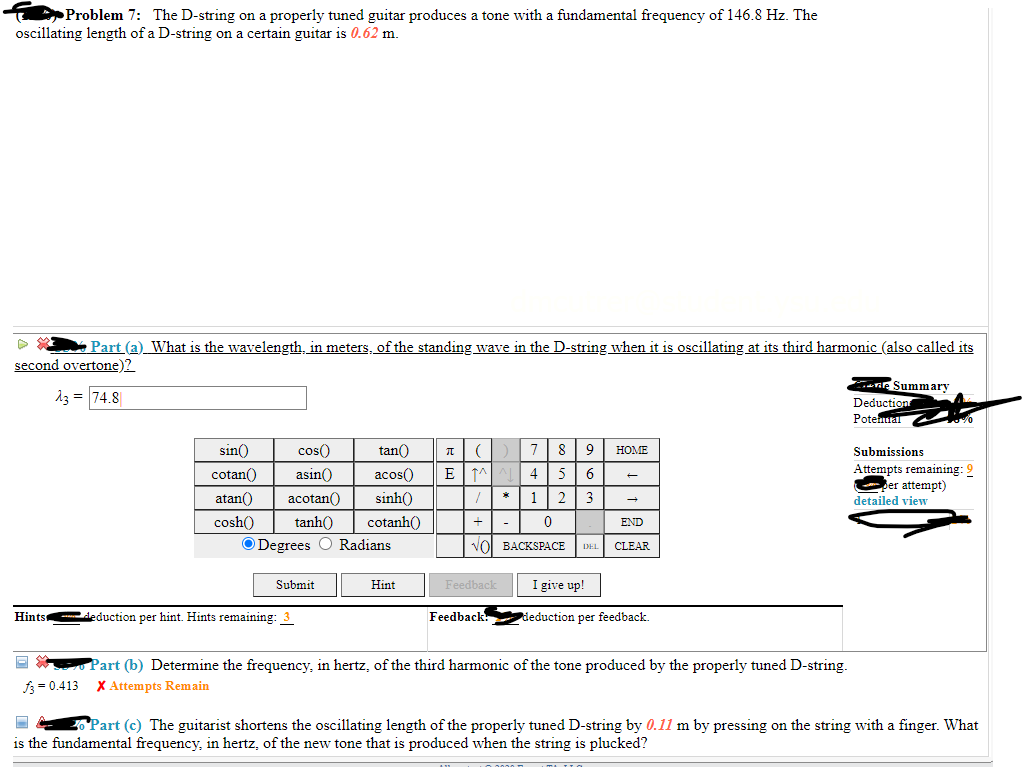Problem 7: The D-string on a properly tuned guitar produces a tone with a fundamental frequency of 146.8 Hz. The oscillating length of a D-string on a certain guitar is 0.62 m. Part (a)_What is the wavelength, in meters, of the standing wave in the D-string when it is oscillating at its third harmonic (also called its second overtone)? ie Summary 13 = 74.8 Deduction Potemual sin() cos() tan() 8 9 НОМЕ Submissions E 1^ Attempts remaining: 9 er attempt) cotan() asin() acos() 4 5 6 atan() acotan() sinh() 1| 2 * 3 detailed view cosh() tanh() cotanh() END O Degrees O Radians VOI BACKSPACE CLEAR Submit Hint Feedback I give up! Hints deduction per hint. Hints remaining: 3 Feedback. ieduction per feedback. E Part (b) Determine the frequency, in hertz, of the third harmonic of the tone produced by the properly tuned D-string. f3 = 0.413 X Attempts Remain 26 Part (c) The guitarist shortens the oscillating length of the properly tuned D-string by 0.11 m by pressing on the string with a finger. What is the fundamental frequency, in hertz, of the new tone that is produced when the string is plucked?
Problem 7: The D-string on a properly tuned guitar produces a tone with a fundamental frequency of 146.8 Hz. The oscillating length of a D-string on a certain guitar is 0.62 m. Part (a)_What is the wavelength, in meters, of the standing wave in the D-string when it is oscillating at its third harmonic (also called its second overtone)? ie Summary 13 = 74.8 Deduction Potemual sin() cos() tan() 8 9 НОМЕ Submissions E 1^ Attempts remaining: 9 er attempt) cotan() asin() acos() 4 5 6 atan() acotan() sinh() 1| 2 * 3 detailed view cosh() tanh() cotanh() END O Degrees O Radians VOI BACKSPACE CLEAR Submit Hint Feedback I give up! Hints deduction per hint. Hints remaining: 3 Feedback. ieduction per feedback. E Part (b) Determine the frequency, in hertz, of the third harmonic of the tone produced by the properly tuned D-string. f3 = 0.413 X Attempts Remain 26 Part (c) The guitarist shortens the oscillating length of the properly tuned D-string by 0.11 m by pressing on the string with a finger. What is the fundamental frequency, in hertz, of the new tone that is produced when the string is plucked?
Related questions
Question

Transcribed Image Text:Problem 7: The D-string on a properly tuned guitar produces a tone with a fundamental frequency of 146.8 Hz. The
oscillating length of a D-string on a certain guitar is 0.62 m.
Part (a)_What is the wavelength, in meters, of the standing wave in the D-string when it is oscillating at its third harmonic (also called its
second overtone)?
ie Summary
13 = 74.8
Deduction
Potemual
sin()
cos()
tan()
8
9
НОМЕ
Submissions
E 1^
Attempts remaining: 9
er attempt)
cotan()
asin()
acos()
4
5
6
atan()
acotan()
sinh()
1| 2
*
3
detailed view
cosh()
tanh()
cotanh()
END
O Degrees O Radians
VOI BACKSPACE
CLEAR
Submit
Hint
Feedback
I give up!
Hints
deduction per hint. Hints remaining: 3
Feedback. ieduction per feedback.
E Part (b) Determine the frequency, in hertz, of the third harmonic of the tone produced by the properly tuned D-string.
f3 = 0.413 X Attempts Remain
26 Part (c) The guitarist shortens the oscillating length of the properly tuned D-string by 0.11 m by pressing on the string with a finger. What
is the fundamental frequency, in hertz, of the new tone that is produced when the string is plucked?
Expert Solution
This question has been solved!
Explore an expertly crafted, step-by-step solution for a thorough understanding of key concepts.
This is a popular solution!
Trending now
This is a popular solution!
Step by step
Solved in 5 steps
